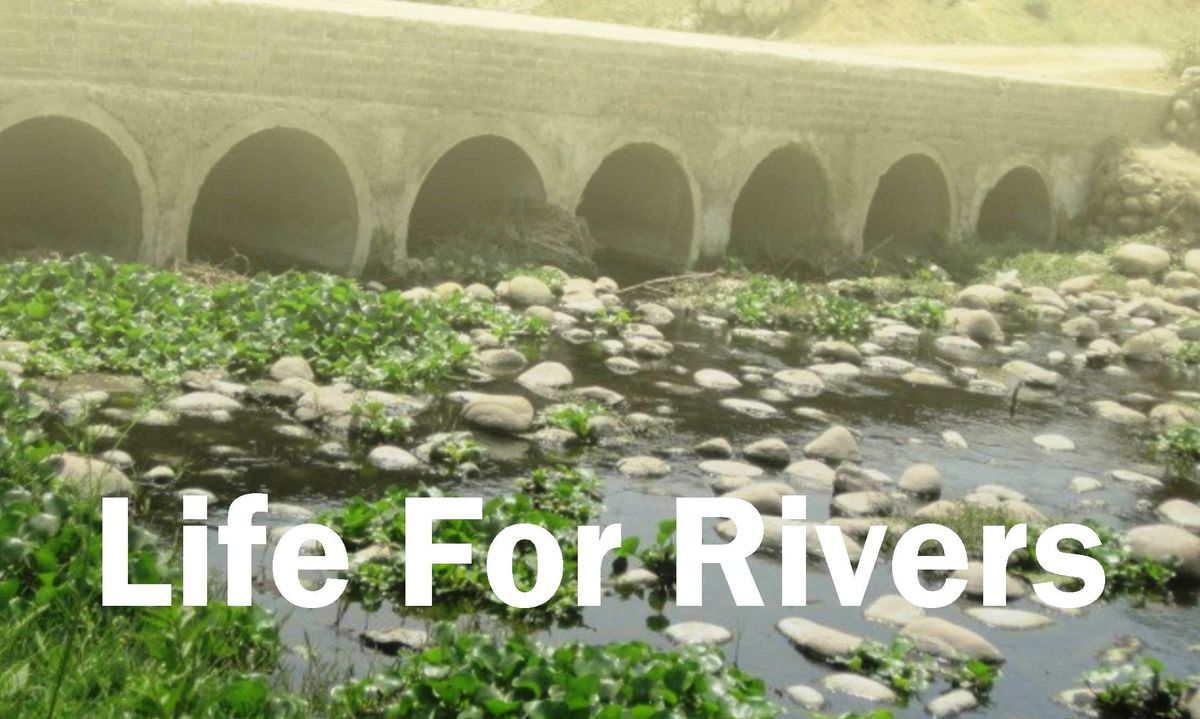
INTRODUCTION
The Kali River East, a tributary of the Ganges, originating in AntWada village in Muzaffarnagar District flows through eight Districts of Uttar Pradesh before its confluence with Ganga River near Kannauj. The river has over 1,200 villages situated on its bank and the highly populated and predominantly rural catchment is entirely dependent on the Kali River as a water resource for domestic, agricultural and industrial use while the untreated groundwater is the primary source of drinking water.
But, since last two decades the river is being used as a dumping ground with substantial quantities of contaminants and untreated effluents from numerous sources disposed into it along its course. The major factors are industrial untreated effluents, domestic sewages, agricultural runoff, indiscriminate use of polythene etc.
Industrial usage is the main cause of pollution of the Kali River (East). Key industries including sugar processing unit and their associated alcohol manufacture distilleries, paper mills, dairies, tanneries are situated adjacent to the river. The sugar mills and paper mills are enlisted in the 17 most toxic waste releasing industries. These industries not only abstract large volumes of water during their manufacturing processes reducing dilution of pollutants present within the surface water bodies but also contaminate the river adversely by draining their effluent wastes into it.
Secondly, Kali Nadi receives a large volume of untreated raw human excreta from thousands of major and minor habitations. In other words, it serves as a trunk sewer of major cities and urban towns. It also includes domestic wastes such as soda, DDT, BHC, petroleum products, etc. which indicates that it contains a wider range of heavy metal parameter.
Thirdly, Western U.P being an intensely agricultural region, a considerable volume of chemical fertilizers, pesticides, rodenticides, etc. are used. These chemicals and heavy metals flow into the river through the process of erosion and through soil to the underlying aquifers causing contamination of this important water resource.
Besides sewage flow, domestic waste flow and dead animals are also dumped in the river water. The dead bodies of people suffering from certain infectious diseases are also dumped in the river which spreads pollution and may lead to epidemics. The polluted river carries water borne viruses and bacteria and is responsible for ill health of the people.
Due to this mismanagement of a vital water resource, its physio-chemical qualities have deteriorated to such an extent that it has affected the ground water too. The foul taste and odour manifest that the water of the Kali River is importable. However, the marginalized community residing within the catchment area is bound to consume the highly polluted water. The residents are left with no option other than either to fend themselves or die of neglect.
PROJECT DETAILS
Project Duration:
February 2015—January 2016
Target Geographical Area:
Full length of the East Kali River from Muzafarnnagar district to Kannuaj district, in Uttar Pradesh state.
Project Objectives:
- To study the quality of the Kali River throughout its catchment .
- To study the groundwater sources near the river catchment.
- Comparing the deterioration of the river water quality and groundwater quality, within the span of twelve months.
- To study extent and movement of pollutants in aquifer due to intense contamination of surface water.
- Placing the water quality analysis data on the GIS platform.
- Publish the findings in the form of a study report, thus, sensitize the community, policy makers and other to plan further action to save this dying river..
CONDITION OF EAST KALI RIVER
Before initiating research of East Kali River, study of whole Kali River from Antwada to Kannauj was conducted.
The Kali originates from the forest region in Antwada village in Jaansad tehsil of Muzafarnnagar district in form of a small stream, flowing for about 3 kms as clear waters. On the way to Khatauli – Mirapur road, black stenching waters of Khatauli sugar mill finds its way to the Kali.
After 10 kms of its journey with black waters, it enters Meerut district. It passes Nagli aashram in Meerut district. The water here is quite dirty. It dries up on its way onwards.
The dry river reaches another 10-15 kms towards Daurala – Lavad road where the drain of Daurala sugar mill flows into the dry river giving it black stanching but water for life. Passing Panwadi, Dhanju and Dedva villages, the river moves ahead of Meerut – Mawana road, where the drains of half a dozen paper mills of Saini, Phitkari and Rafen villages flow into the river.
Moving ahead to Meerut city, the river passes through Jaibheem nagar colony where PAC drain carrying the city wastes meets the river. This sewage also consists of wastes of Daurala Chemical plant and color factory.
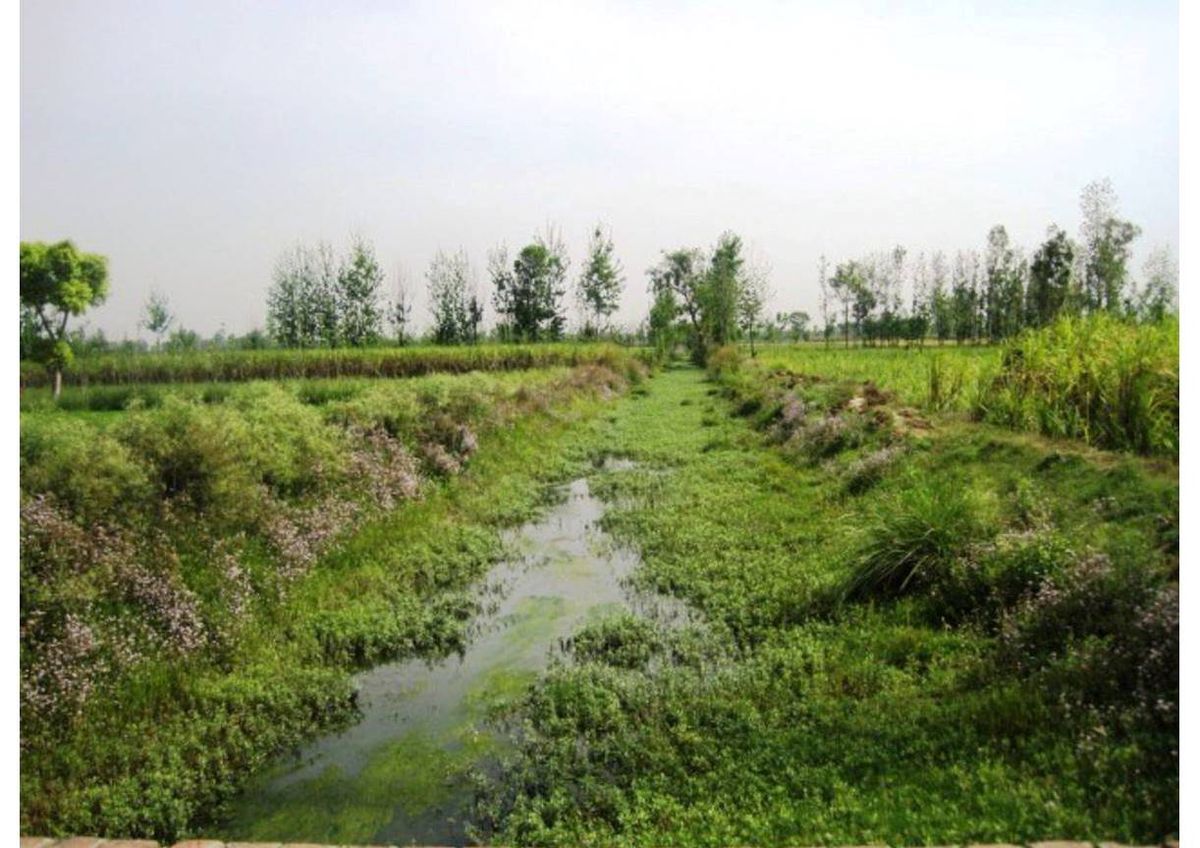
The river moves ahead carrying large quantity of wastage yet for 5 kms, the animal carcasses and bloody wastage of butcher house of Meerut nagar nigam is also dropped into the river. The river passes through Aadh, Kudhla, Kaul, Bhadoli and Atrara villages and flows about for 20 kms before entering Hapur district.
Then passing through Hapur- Garh road, after 30 kms the river enters Bulandshar district. The sewage of bulandshahar city is also dumped into it. After about 50 kms, the river enters Aligarh district. The wastage of Aligarh distillery and butcher houses is dumped into the river.
As the river crosses Aligarh, the pollution level decreases. The first reason for it is the fresh river water which is added at the Harduaganj Bhudansi at Aligarh and second reason being no industrial waste being added between Aligarh and Kannauj where it meets Holy Ganga. From Aligarh, it flows towards Kaasganj. There is a spectacular view of rivers at Kaasganj.
The Kali River flows from under another river on the bridge. This bridge was constructed in 18th century and is 200 mts long. From Kaasganj, the river flows into Eta district, from there to Farukkhabad and at the end to Kannauj district. At Kaasganj, Eta, Farrukhabad and Kannauj districts, no industry dumps its wastes in to the Kali and neither the city sewage is dumped into it.
After Eta, the sewage of Gursaiganj township is dumped into Kali, but the the river water becomes clearer onwards. But, a drain is being constructed by Uttar Pradesh govt at Kannauj city, to carry and dump the sewage of the city into the river.
The distance travelled between Kaasganj and Kannauj by the river is almost 150 kms. This length of river is far cleaner than the same length between Muzafarnnagar to Aligarh. When the Kali flows into Ganga at Kannauj, it becomes difficult to differentiate the Ganga and Kali waters.
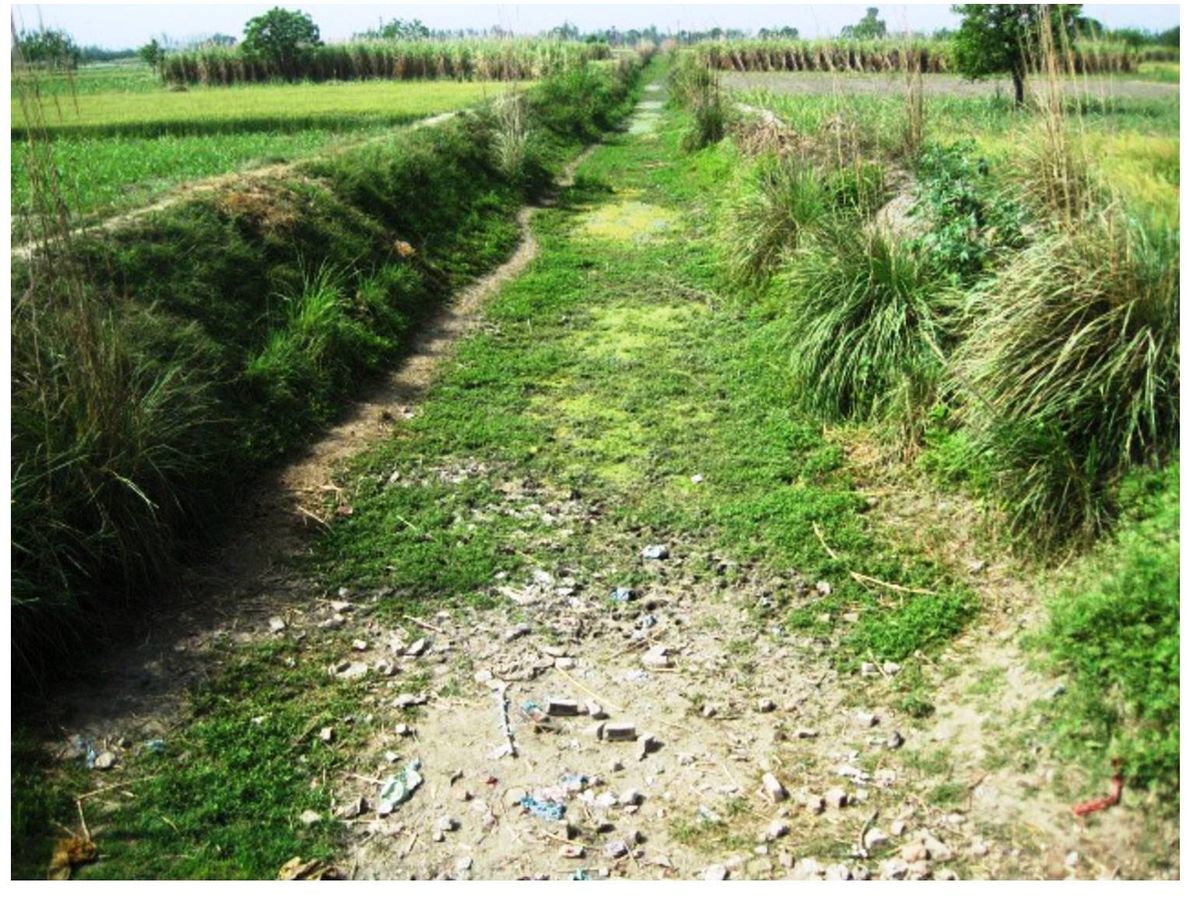
LOCATION AND CONDITION OF SAMPLES
The first river water sample was taken from the river at Khatauli – Jaansadh road, after the Khatauli Sugar mill releases its waters in the river and first private handpump sample taken from Antwada village.
The second river water sample was taken from near Jalalpur village of Meerut district and groundwater water sample from govt. School of the village.

The third sample was collected from under the bridge at Babugarh cantt Lalpur – Tatarpur village on NH 24 and groundwater sample from a nearby govt handpump.
The fourth sample was taken from under the bridge Shikarpur at Rampur village on Bulandshahar – Shikarpur road and underground water sample from a private handpump of Mr. Hukum Singh from Rampur village.
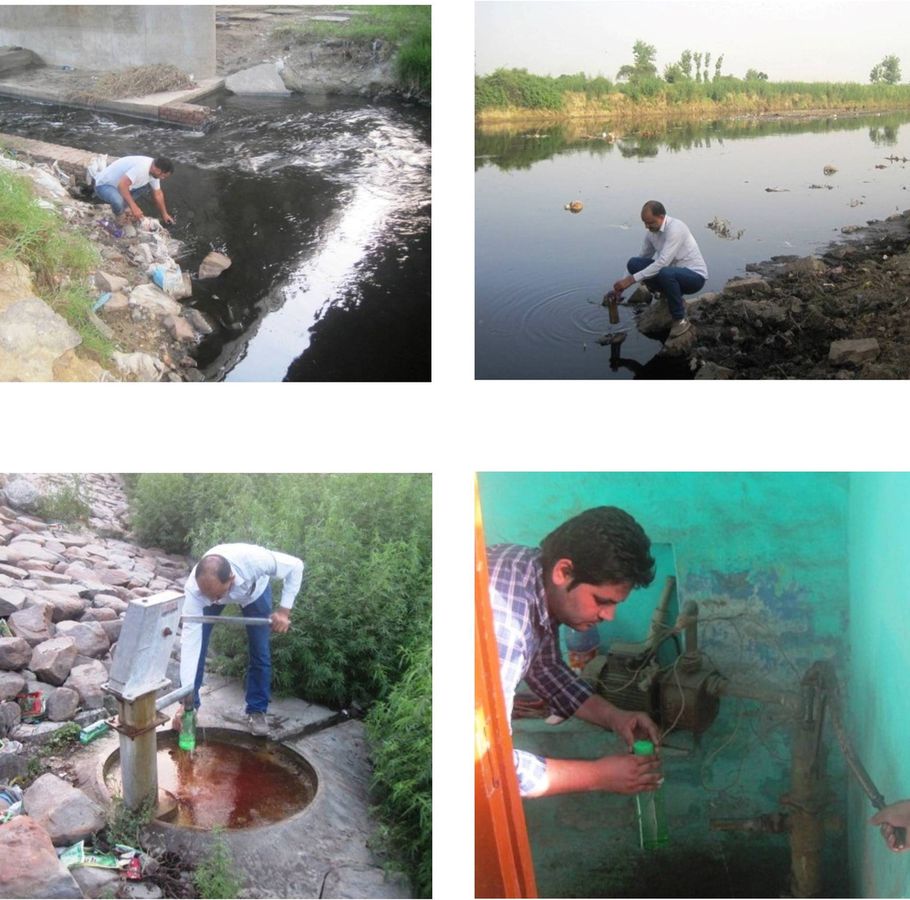
The fifth sample was taken from Kali Nadi Bridge, near the Aligarh distillery at Ahemdpura village of Dhanipur block, around 12 kms away from Aligarh city on Ramghaat road. The river water here is black in color with bad smell. Standing near the river becomes impossible due to the stench.
After the collection of samples, the team moved towards Panethi from Ahemdpura. Panethi is a town and has an airstrip. Passing Shekhajheel, the team reached Kaudiyaganj village near the river. There is no bridge here to cross the river. The people have to cross it through boats. It is common to use river water for irrigating the fields nearby. Kaudiyaganj village falls in Akarabad block.
The fifth underground water sample was taken from a private handpump nearby the river. This village is known for its famous resident Poet Jaynandre and one famous singer. The residents told the team about the stench of water some days when river water flowing from Aligarh is too dirty at times.
After collecting samples from here, the team moved towards Kaasganj. The view of Kali River at Kaasganj is spectacular. From Aligarh moving towards Kaasganj on the main road for around 3 kms along the riverside, the Kali River is seen flowing below a bigger river atop a bridge. This bridge is very large which was built in year 1875. A village Nadrai is situated near this bridge where Kashiram housing colony is also located.
The sixth river water sample was taken from under the bridge and underground water sample from a govt handpump at the housing colony. The sewage of Kaasganj is also dumped into Kali River.
The team moved forward towards Eta. The Kali River is seen on the way towards Eta but there is industry or city nearby therefore no wastage is dumped in this vicinity. But after Eta, the sewage of Gursaiganj is seen to be dumped in the river. The team moved forward towards Farrukhabad.
The seventh sample of Kali River water was collected from nearby the bridge at Khudaganj on the way to Farrukhabad from Gursaiganj.
The underground water sample was collected from a private handpump of Mrs. Champadevi’s premises at Khudaganj village. The water was found not too polluted at this location.
This bridge falls into Farrukhabad and Kannuaj districts. The Kali River defines the limits of both the districts here. Kannauj lies in the east and Farrukhabad in the west. There are two bridges here, one for road vehicles and other for railways.
From here the team entered the Kannauj district. The team passed through the road marked on the name of King Jaychand’s daughter Sanyogita. The Kali River flowes below the bridge on this road. The team reached Kannauj through this way. The Uttar Pradesh govt is constructing a big drain near the palace of King Jaychand. This sewage drain will run from the city to the Kali River.
This drain will meet the Kali River before the “Gauri-Shankar”. The river reaches the chaura Chandpur ahead. When moving towards Chaura Chandpur, a small village Rijgir lies in between. “Aala-Udal”, a prominent officer in the court of King Harshvardhan had stayed at Rijgir.
From here the river travels for about 4-5 kms from Kannauj on Hardoi road before merging into Ganga on Mendiganj ghaat at Gangaraj village. The water of the Kali River is seen to be clear to an extent.
The eight sample of the river water was taken here before it merges in the Ganga.

The eight sample underground water sample was taken from a govt handpump of the Gangaraj village.
The journey which started at the East Kali River’ originating point at Antwada village of Jaansadh tehsil in Muzafarnnagar district, finally came to an end at Mendiganj ghaat at Gangaraj village in Kannuaj district where the Kali flowed into Ganga.
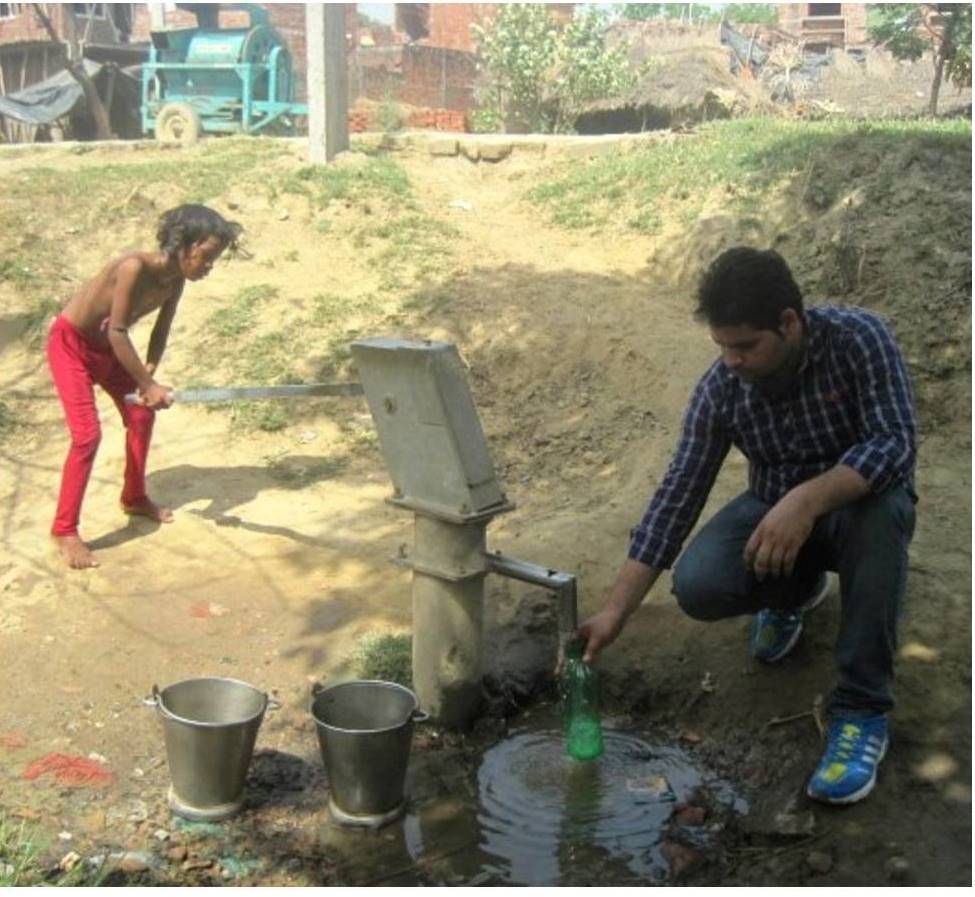
During this journey, the team passed through nine districts namely Muzafarnnagar, Meerut, Hapur, Bulandshahar, Aligarh, Kaasganj, Eta, Farukkhabad and Kannauj, in which leaving Eta, water samples were collected from all other eight districts.
These samples have been sent for testing at laboratory of People’s Science Institute, Dehradun.
DETAILS OF COLLECTED SAMPLES
DETAILS OF RESULTS
GIS LOCATIONS
HISTORY OF KALI RIVER (EAST)
The original originating source of East Kali River in forest of Antwada village of Jaansad tehsil of Muzafarnagar district has now turned into sugarcane fields of farmer Vinod Kumar. Now the origination point has turned to a govt drain which flows from nearby.
According to aged residents of the Antwada village, there is an ancient story about the origination of the river. Once upon a time, a saint lived across the village, in a hut near a mahale tree. He would goto Ganga in Shukratal every morning to bathe. When he got old, it became a difficult task. So one day he goes to Ganga and after bathing, he prayed to Holy Ganga that he wont be able to come again there as it was no longer possible for him to travel this distance everyday, and if Holy Ganga wishes for him to bathe in Ganga everyday, then it will have to come to his place at Antwada. Then he returned back to his hut.
Next day, a bull started hitting at the mahale tree near the saint’s hut. Due to bull’s actions, a group of snakes residing in the tree came out. Among them, there was a female snake which went towards south direction. It is believed that a water stream followed her wherever she passed.
Other streams also merged into this stream along the way, shaping it into a river. Therefore, it is believed that the origin of this river is from that tree. Hence, it was named “Naagin River”. The saint bathed in this stream everyday until his death.
In the scientific view, the groundwater level of the area around Antwada village is much higher than other regions (even today at 10 feet) that water flowed naturally from that point. The water flowed in a stream and when other streams joined it, it became into a river. But the scientists and researchers do not have a say on the name of the river.
In this region, snakes were found in abundance along with dense grass shrubs. The ground water level decreased along the time and therefore the original point of Kali River also dried up. The farmers filled this stream and turned them into farming fields. The drain near these fields which flows from Nithari village contains some water from the ground itself.
WATER IN KALI RIVER
What is the river? Constant stream of livegiving fresh water is known as a river. In the same context, Ganga – Yamuna alongwith Kali River can not be called as rivers today because its major part has been dried or is facing illegal mining of sand, but approximately 5-6 kilometers towards south at Saini village the water starts appearing in the river stretch which increases towards Gokulpur. Not only this, towards Bulandshahr it appears as a river having less water. It can be said that in the North of Meerut distrct, the river is dry whereas towards south ti has water flowing throughout the stretch.
Alongwith Daurala sugar mill, Devpriya Group of Industries, Mawana Sugar Mill, United Spirits, Limited Meerut Cantt, 6 drains along with Odeon stream of Meerut city that carries blood and flesh pieces from slaughter house contribute to the water stream in the river. Another thing is that should it be referred as water or not? Should it be called as water or poison?
WATER & POISON
Water & poison, both emerged from the same power, as believed in our ancient scriptures. Both are liquid but one gives life and other takes life. Therefore water is also called boon and poison is called death. It actually signifies that the liquid which takes life becomes death. The same happened with Kali River. The river which once gave life to people and nature is now so polluted that it has turned into flowing death.
It has been turned into dumping drain in which all sorts of garbage is flowing. The river which gave life to others is now dying to get its own life back. Along its 300 kms long stream, it is being used as a drain and has been made poisonous. It also polluted the Holy Ganga when it merges with it at Kannauj and also polluting the ocean through Ganga.
FIRST STEP TOWARDS THE POLLUTION OF THE RIVER
At the origination point, the river is seen as a drain itself, but after flowing for about one kilometre, it takes shape of a river. It crosses the Khatauli – Jaansad road, passing Bhalwa & Palri villages and reaches Khatauli – Mirapur road. In between the underground water flows in the river by itself which shines like pearls. But the river is polluted by the drain of Triveni sugar mill at Khatauli.
From here onwards, the polluted travel of the river begins. The river begins to stench from here. It flows through Ramnagar, Aaaiyapur, Rasoolpur Calora big & small, Khakhani, Gaalibpur, Jaavand, Jasola, Sikandarpur, Mandwadi, Kadhli, Nagli, Shahpur, Mamuri, Tandi, Mishripur, Bansipura, Sarsaava and Akhyaatpur villages. But the river dried up at the village Khedi. Here illegal mining of sand and soil is carried out.
This dry river finally fined its way to Daurala – Laavad road after passing Samoli Salempur. The drain of Shriram sugar mill at Daurala meets the river just before mandwari village. The river finally gets water but dirty. It travels to Panwadi, Ajhota, Iklauta, Methepur, Dedva, Jalapur, and Ulakhpur but dries up at Indrajeetpur again.
The dried river travels to Nagla Mukhtayaarpur, Bahchaula and Saini village. The dirty water of six paper mills, owned by three different owners is dumped into Kali at Saini village, through numerous drains.
It includes Devpriya mill, Anand mill and Bonanza paper mill. From the Saini village, passing from Meerut – Mawana road it moves towards Akbarpur, Silaapur, Rasoolpur, Aurangabad, Bhoodpur and Chilora villages, crossing the Meerut – Parixitgarh road.
In between, city sewage drain and dumps of various industries is flown into the river. Also dumps of Ashok handlooms and Meerut medical college are also flown in the river. The river is yet again polluted by dumps at various locations ahead.
POLLUTANTS
Till the decade of 80s, the river water was so safe that the Bengali Community of Meerut at the time of Durga Puja celebrations used to immerse the idle of Goddess Durga in it however, now the river has changed literally black in color.
The untreated effluents of chemical plants, sugar mills, distilleries and slaughter houses etc. have made this river almost dead. The water has turned black with hardly any oxygen in it. Like all other rivers the Kali Nadi is also considered as pious and aesthetic.
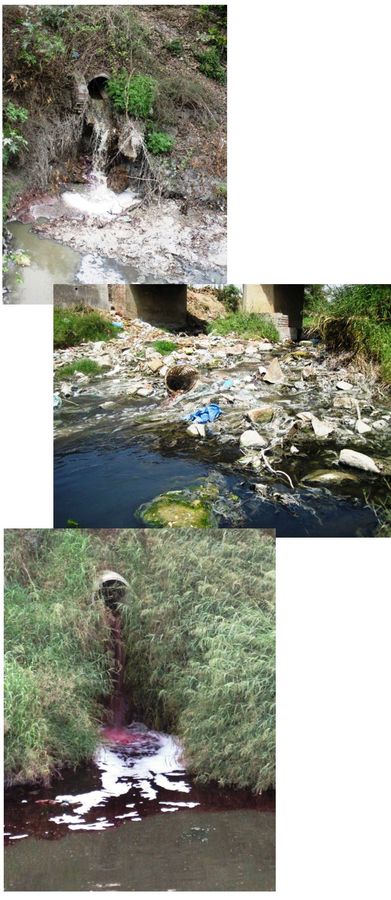
The river has got the name since it is believed that it used to cure black cough (Kali Khansi). Since last two decades the river is being used as a dumping ground with substantial quantities of contaminants and untreated effluents from numerous sources disposed into it along its course.
The major factors are industrial untreated effluents, domestic sewages, agricultural runoff, indiscriminate use of polythene etc.
REPORTS
According to the study conducted by Central Ground Water Board in the year 1999-2001, the results of hundreds of samples collected along the total length of the river water (river water and hand pump) were really shocking. In these samples, lead, chromium, iron, zinc, alongwith other elements were found to be present. According to the report villages namely Chidora, Yahiyapur and Jamad of Muzaffarnagar district; Dhanju, Dedwa, Ulaspur, Bichaula, Mainthna, Rasulpur, Gesupur, Kudhla, Muradpur Badaula, Kaul, Jaibheemnagar and Yadnagar of Meerut district; Ajrada and Hapur in Ghaziabad; Akbarpur, Sadharanpur and Utsara, Ajitpur, Laughara, Mankhera, Baknaura and Anchrukla in Bulandshahr district; Mainpur, Sikandarpur and Rasooli in Aligarh and Rajpura, Baalipura and Nveenganj in Kannauj suffer badly from the pollution of the river. The life in these villages is miserable due to non availability of safe drinking water. According to the report, upto the depth of 30-35 m at Meerut and Ghaziabad as well as its surrounding areas, heavy metals have been found in large limits exceeding the standards.
EFFORTS BY THE GOVERNMENT
For this highly polluted river which has almost turned into a dirty drain, on being pressurized by the Human Rights Commission, the Planning Department of Uttar Pradesh Government has prepared a scheme worth Rs. 88 Crores to make the river pollution free. For this task, National River Conservation Directorate, Government of India and Japan Bank for International Operations have been requested for extending financial support.
But since the earlier schemes supported by the bank were not properly implemented, it has refused to support the amount being requested. It seems as if the Pollution Control Board is sleeping. They are well aware that the industries are releasing their untreated waste into the rivers in open but no action being taken against them is totally beyond comprehension.
But yes, during Sangam Mela when the saints refused taking bath in the polluted river then forcefully the board had to ban a few industries which included three paper mills of Meerut also. But today again all the industries are releasing the waste water into the river.
Several small as well as large drains of Meerut city carrying non-treated domestic
Waste, fall into the river making it highly polluted which contains waste from slaughter houses, too, being operated in the city. By disposal of slaughter house waste into the river, the remains of animals also enter into the water.
These wastes are then brought into the villages by dogs and other animals which increase the risk of infections to a high extent. Meerut is to be developed under the Jawaharlal Nehru Urban Renewal Mission programme wherein water treatment plants also have to be installed so that the water is released into the river after proper treatment. But when and how will the plan be implemented, is a million dollar question.
LASTLY
Somewhere for this dark journey of river Kali (East), we ourselves are responsible as in the rush of modernity we have sacrificed our values and duties. It is said that if anybody pollutes river water anyhow, the person should be strictly punished. Where has all our faith gone which used to be for the rivers? Which direction are we and our society heading? It is a matter of serious concern.






 tag on profile.
tag on profile.
By Raman Kant {{descmodel.currdesc.readstats }}
Raman Kant {{descmodel.currdesc.readstats }}
INTRODUCTION
The Kali River East, a tributary of the Ganges, originating in AntWada village in Muzaffarnagar District flows through eight Districts of Uttar Pradesh before its confluence with Ganga River near Kannauj. The river has over 1,200 villages situated on its bank and the highly populated and predominantly rural catchment is entirely dependent on the Kali River as a water resource for domestic, agricultural and industrial use while the untreated groundwater is the primary source of drinking water.
But, since last two decades the river is being used as a dumping ground with substantial quantities of contaminants and untreated effluents from numerous sources disposed into it along its course. The major factors are industrial untreated effluents, domestic sewages, agricultural runoff, indiscriminate use of polythene etc.
Industrial usage is the main cause of pollution of the Kali River (East). Key industries including sugar processing unit and their associated alcohol manufacture distilleries, paper mills, dairies, tanneries are situated adjacent to the river. The sugar mills and paper mills are enlisted in the 17 most toxic waste releasing industries. These industries not only abstract large volumes of water during their manufacturing processes reducing dilution of pollutants present within the surface water bodies but also contaminate the river adversely by draining their effluent wastes into it.
Secondly, Kali Nadi receives a large volume of untreated raw human excreta from thousands of major and minor habitations. In other words, it serves as a trunk sewer of major cities and urban towns. It also includes domestic wastes such as soda, DDT, BHC, petroleum products, etc. which indicates that it contains a wider range of heavy metal parameter.
Thirdly, Western U.P being an intensely agricultural region, a considerable volume of chemical fertilizers, pesticides, rodenticides, etc. are used. These chemicals and heavy metals flow into the river through the process of erosion and through soil to the underlying aquifers causing contamination of this important water resource.
Besides sewage flow, domestic waste flow and dead animals are also dumped in the river water. The dead bodies of people suffering from certain infectious diseases are also dumped in the river which spreads pollution and may lead to epidemics. The polluted river carries water borne viruses and bacteria and is responsible for ill health of the people.
Due to this mismanagement of a vital water resource, its physio-chemical qualities have deteriorated to such an extent that it has affected the ground water too. The foul taste and odour manifest that the water of the Kali River is importable. However, the marginalized community residing within the catchment area is bound to consume the highly polluted water. The residents are left with no option other than either to fend themselves or die of neglect.
PROJECT DETAILS
Project Duration:
February 2015—January 2016
Target Geographical Area:
Full length of the East Kali River from Muzafarnnagar district to Kannuaj district, in Uttar Pradesh state.
Project Objectives:
CONDITION OF EAST KALI RIVER
Before initiating research of East Kali River, study of whole Kali River from Antwada to Kannauj was conducted.
The Kali originates from the forest region in Antwada village in Jaansad tehsil of Muzafarnnagar district in form of a small stream, flowing for about 3 kms as clear waters. On the way to Khatauli – Mirapur road, black stenching waters of Khatauli sugar mill finds its way to the Kali.
After 10 kms of its journey with black waters, it enters Meerut district. It passes Nagli aashram in Meerut district. The water here is quite dirty. It dries up on its way onwards.
The dry river reaches another 10-15 kms towards Daurala – Lavad road where the drain of Daurala sugar mill flows into the dry river giving it black stanching but water for life. Passing Panwadi, Dhanju and Dedva villages, the river moves ahead of Meerut – Mawana road, where the drains of half a dozen paper mills of Saini, Phitkari and Rafen villages flow into the river.
Moving ahead to Meerut city, the river passes through Jaibheem nagar colony where PAC drain carrying the city wastes meets the river. This sewage also consists of wastes of Daurala Chemical plant and color factory.
The river moves ahead carrying large quantity of wastage yet for 5 kms, the animal carcasses and bloody wastage of butcher house of Meerut nagar nigam is also dropped into the river. The river passes through Aadh, Kudhla, Kaul, Bhadoli and Atrara villages and flows about for 20 kms before entering Hapur district.
Then passing through Hapur- Garh road, after 30 kms the river enters Bulandshar district. The sewage of bulandshahar city is also dumped into it. After about 50 kms, the river enters Aligarh district. The wastage of Aligarh distillery and butcher houses is dumped into the river.
As the river crosses Aligarh, the pollution level decreases. The first reason for it is the fresh river water which is added at the Harduaganj Bhudansi at Aligarh and second reason being no industrial waste being added between Aligarh and Kannauj where it meets Holy Ganga. From Aligarh, it flows towards Kaasganj. There is a spectacular view of rivers at Kaasganj.
The Kali River flows from under another river on the bridge. This bridge was constructed in 18th century and is 200 mts long. From Kaasganj, the river flows into Eta district, from there to Farukkhabad and at the end to Kannauj district. At Kaasganj, Eta, Farrukhabad and Kannauj districts, no industry dumps its wastes in to the Kali and neither the city sewage is dumped into it.
After Eta, the sewage of Gursaiganj township is dumped into Kali, but the the river water becomes clearer onwards. But, a drain is being constructed by Uttar Pradesh govt at Kannauj city, to carry and dump the sewage of the city into the river.
The distance travelled between Kaasganj and Kannauj by the river is almost 150 kms. This length of river is far cleaner than the same length between Muzafarnnagar to Aligarh. When the Kali flows into Ganga at Kannauj, it becomes difficult to differentiate the Ganga and Kali waters.
LOCATION AND CONDITION OF SAMPLES
The first river water sample was taken from the river at Khatauli – Jaansadh road, after the Khatauli Sugar mill releases its waters in the river and first private handpump sample taken from Antwada village.
The second river water sample was taken from near Jalalpur village of Meerut district and groundwater water sample from govt. School of the village.
The third sample was collected from under the bridge at Babugarh cantt Lalpur – Tatarpur village on NH 24 and groundwater sample from a nearby govt handpump.
The fourth sample was taken from under the bridge Shikarpur at Rampur village on Bulandshahar – Shikarpur road and underground water sample from a private handpump of Mr. Hukum Singh from Rampur village.
The fifth sample was taken from Kali Nadi Bridge, near the Aligarh distillery at Ahemdpura village of Dhanipur block, around 12 kms away from Aligarh city on Ramghaat road. The river water here is black in color with bad smell. Standing near the river becomes impossible due to the stench.
After the collection of samples, the team moved towards Panethi from Ahemdpura. Panethi is a town and has an airstrip. Passing Shekhajheel, the team reached Kaudiyaganj village near the river. There is no bridge here to cross the river. The people have to cross it through boats. It is common to use river water for irrigating the fields nearby. Kaudiyaganj village falls in Akarabad block.
The journey which started at the East Kali River’ originating point at Antwada village of Jaansadh tehsil in Muzafarnnagar district, finally came to an end at Mendiganj ghaat at Gangaraj village in Kannuaj district where the Kali flowed into Ganga.
During this journey, the team passed through nine districts namely Muzafarnnagar, Meerut, Hapur, Bulandshahar, Aligarh, Kaasganj, Eta, Farukkhabad and Kannauj, in which leaving Eta, water samples were collected from all other eight districts.
These samples have been sent for testing at laboratory of People’s Science Institute, Dehradun.
DETAILS OF COLLECTED SAMPLES
DETAILS OF RESULTS
GIS LOCATIONS
WATER IN KALI RIVER
WATER & POISON
FIRST STEP TOWARDS THE POLLUTION OF THE RIVER
POLLUTANTS
REPORTS
EFFORTS BY THE GOVERNMENT
LASTLY
Attached Images